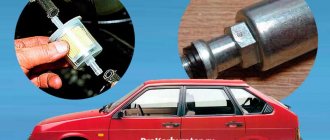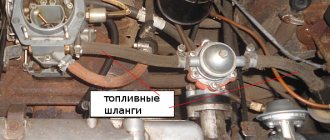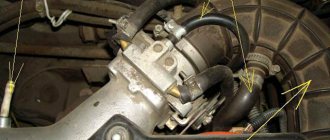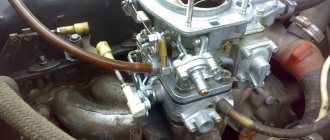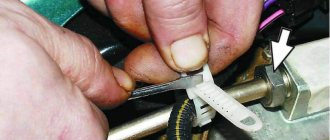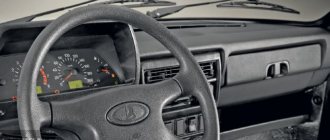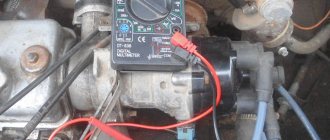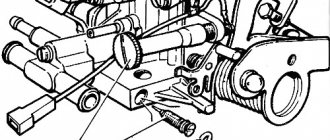Idle speed refers to the operation of the power unit in neutral gear, that is, when the engine runs “idling” without providing forward motion of the vehicle. The need for this arises quite often, especially when starting the engine after a long period of inactivity, when it needs to be warmed up a little to ensure the penetration of lubricant into all channels and components.
While the car is moving, the engine output, that is, the rotation speed of the crankshaft, is regulated by the driver by pressing the accelerator pedal. In principle, the same could be done with the operation of the power unit at idle speed, but this is extremely inconvenient, which is why the very concept of idle speed arose - a mode in which the engine operates at minimum speed and does not stall. Adjusting the idle speed is done differently on engines with an injection system and a carburetor: in the first case, the on-board computer paired with the idle regulator is responsible for this, in the second - the carburetor itself. But from time to time their settings get lost, which leads to the need to adjust the idle speed manually - if this is not done, the engine will operate unstably in idle mode or even stall.
We clarify how to adjust the idle speed on a VAZ 2114
Every car enthusiast with extensive driving experience remembers when Russian roads were filled with Zhiguli and Muscovites.
These cars were distinguished by the fact that almost every car enthusiast could repair them on his own. The VAZ 2114 is also a fairly simple car when it comes to repairs. Any car enthusiast who has at least a little knowledge of cars can cope with troubleshooting this machine.
Almost all the key elements of this car can be adjusted mechanically, but some parts of the car cannot be repaired using the old-fashioned method.
How to increase idle speed on an injector VAZ 2114
The low speed of the VAZ 2114 can be adjusted using a special sensor for idle speed, although in a modern VAZ it is no longer as easy to adjust the idle speed as it was before. In order to understand all the nuances, you should study the structure of some elements of the car.
What does the injector consist of?
The injector on this car does not consist of one part, but is a complex structure that includes:
Each part of the injector performs a specific function, so even if any sensors fail, the functioning of the car can be seriously impaired. In order to correct the situation, the help of a qualified technician may be required.
Sensors
Today, various technologies and methods are used to supply fuel to the VAZ 2114. This process is monitored using sensors. In addition, the car is equipped with additional tracking systems that make it possible to determine the indirect reasons for its overuse.
The most popular of them are the following:
- Oxygen sensors.
- Crankshaft sensors.
- PD sensors.
- Knock sensors and some others.
How to adjust idle speed on a VAZ 2114 injector
In order to successfully cope with this task, you should make sure that the idle speed regulator is working properly. What engine speed should the VAZ 2114 be at idle?
Most importantly, they should not float. This is one of the main conditions. In a situation where floating engine speeds occur or the normal functioning of the engine is disrupted when the driver puts the car in neutral, you should think about the causes of the malfunction.
In some cases, the speed increases while the engine is fully warmed up. All this indicates problems associated with the operation of the idle air regulator. The reason may also be a lean mixture.
Another malfunction that may be a consequence of improper operation of the regulator is too low speeds on an engine that is not yet sufficiently warmed up.
The cause of the malfunction is often too much air supply.
In order to make the adjustment, you will need a computer capable of collecting data from a wide variety of sensors installed on the car. It is impossible to do this manually. This means that you won’t be able to do it on your own. Repairs require special equipment.
Additional Information. How can you save on repairs? To ensure that the adjustment does not cost too much, you can look for a private mechanic who has the necessary equipment for repairs.
Using a computer, you can open one or another valve. It is almost impossible to do this otherwise. Under no circumstances should you try to open the valve manually, because this can be dangerous not only for your health, but also for the car, which will completely fail if repaired incorrectly.
It is necessary to open the valve using a computer only with a certain value. If you do not comply with this indicator, then the adjustment will also not work.
Repair rules
The idle speed regulator is a special executive function that is necessary for the engine to operate in normal mode. If it turns out to be faulty, the indicator that indicates this fault will not light up. This means that identifying the problem can be quite simple. All that remains is to eliminate it as soon as possible.
The regulator is a stepper motor that makes it possible to guarantee a certain level of air flow that bypasses the closed damper.
The flow level is set by the car's electronics. Such a complex system allows the motor to operate as evenly and stably as possible. Also, the electronic system of the machine performs the function of protecting against external factors, because the engine operates normally under almost any circumstances.
Operating principle of IAC
This fuel system device operates according to the following algorithm. As soon as the VAZ 2110 has a high idle speed, the controller gives a command to open valve XX, directing the air flow bypassing the throttle valve.
To reduce the frequency value of the crankshaft rotation, he programs the unit to close, while the degree of saturation of the air flow transmitted past the throttle valve decreases.
Checking the idle speed regulator of a VAZ 2110 car for functionality is carried out as follows:
- Disconnect all battery terminals to completely de-energize the vehicle.
- We interrupt the contact between the harness block and the idle speed regulator coming to it.
- Using a professional multimeter, we measure the resistance of the external and internal windings of the IAC, while the resistance parameters of contacts A and B, and C and D should be 40-80 Ohms.
- If the instrument scale is zero, it is necessary to replace the IAC with a working gadget, and if the required parameters are obtained, we check the resistance values in pairs B and C, A and D.
- The device must detect an “open circuit”.
- With such indicators, the IAC is serviceable, and if they are absent, the regulator must be replaced.
When purchasing an IAC, you should carefully study the contents of the box, since counterfeits are very common on the market. Their use can lead to serious engine damage, which will require a large amount of money to fix. How to distinguish an original from a fake is shown in the photo above.
VAZ 2114 has low idle speed
What needs to be done to adjust the operation of such an important part of the car?
- The first thing to do is turn off the battery. Some drivers believe that it is enough to turn off the ignition, but in reality this is not the case. You need to turn off the so-called “mass”.
- When this is done, you need to proceed to unscrew the fasteners holding the regulator. In this way you can completely remove it. This will not be difficult if you do everything carefully and without haste. Some models have one unpleasant feature. The fact is that their screws are filled with special paint. Sometimes they are completely drilled out. In this case, you will have to completely dismantle the damper body. Once this is done, you can disassemble the regulator and remove it.
- Now it’s the turn to clean the landing channel. You can simply rinse it and then treat it with a powerful air stream. A gas can or a simple compressor is suitable for this. The regulator should be disassembled very carefully, otherwise any unpleasant consequences are possible. For example, you can easily damage the winding. After this you need to start checking the bushing. If something is wrong, then it is better to replace it with a new one.
- The next step is to determine the integrity that characterizes the spring. To do this, you can use a special measuring device. It will not be superfluous to clean the winding contacts. Only after this can you start assembling the idle air control, but at the very beginning you need to measure the distance from the conical needle to the flange. It should be 23 mm. If the distance is different, then you need to change the needle.
- The last step is to install the regulator in the place where it was before it was removed from the car. It has its own seat. That's where he needs to be returned. This must be done as carefully as possible. Once the regulator is in place, you need to connect the plug to it. You can do this yourself.
Now it's time to turn on the power. The engine should be started. If you still cannot fix the problems, you will have to disassemble the regulator a second time. If the next attempt is unsuccessful, the driver should be advised to reflash the on-board computer.
This may be relevant for those who purchased a car on the secondary market, but reflashing is a last resort. Usually all car owners just need to disassemble the regulator and repair it.
Choosing a replacement regulator
On the VAZ-2110 with both 8-valve and 16-valve injection engines, a sensor with catalog number 2112-1148300 is used. Additionally, at the end of the marking there is a prefix consisting of two numbers, for example, 01, 02, 03, 04. This index indicates the manufacturer of the regulator (01 and 03 - “Pegasus”, 02 and 04 - KZTA)
When choosing a replacement regulator, pay attention to two nuances - the seal and the height of the needle protrusion above the body. Factory spare parts use a red seal, while counterfeits use a black rubber element.
The height of the needle protrusion above the body is 23 mm.
Before installing a new regulator, it is recommended to coat the sealing ring with a thin layer of engine oil to ensure a tight fit of the part in the seat and eliminate the possibility of air leaks.
How to adjust and configure an injector with your own hands
Hello, dear car owners! Many still remember the times when our people's cars were the legendary Muscovites and Zhigulis.
And every self-respecting car enthusiast, armed with a wrench and a screwdriver, considered it his duty to adjust the carburetor of his car to suit himself.
Gasoline engines of modern cars are equipped with a fuel injection system. This system is completely tied to the electronic “brain” of the car and it is unlikely to be possible to debug its operation with a wrench and a screwdriver.
Today's car enthusiasts, who want to carry out most of the maintenance operations on their car themselves, have in their arsenal, along with keys and screwdrivers, computers with special software.
Self-adjustment of the injector
Having become the owner of a car with a fuel injection system, often not entirely new, most of us, during operation, begin to notice certain deviations in the engine’s operation that we would like to correct. Either we don’t have enough traction, or it seems to be eating more fuel than it should, or it doesn’t work smoothly. It is in such cases that adjustment of the injector is necessary.
To adjust the injector yourself, you need a laptop with installed software that matches the make of your car and a cable for connecting to the on-board computer. The on-board computer has its own firmware, the “brain” of the car, with the help of which all processes are controlled.
By connecting to the on-board computer, you will be able to observe the vehicle parameters, as well as any errors present. Having a certain amount of knowledge, you can easily remove errors yourself.
And with the help of non-standard firmware, which is now easy to obtain, you can make changes to the main firmware of the car’s on-board computer, and thus customize the dynamics of your iron friend.
Chip tuning: customizing the injector for yourself
Injector tuning or chip tuning is the modification of the electronic engine control system in order to obtain the greatest possible improvement in its performance characteristics.
On an experimental car, the factory software is refined and adapted to local fuel and specific weather conditions, and the fuel consumption settings are perfected.
And only then, using modified software, the injector of your car is configured.
As a result, your car will receive:
- fast start
- smooth running at low loads,
- smooth traction in high gears,
- reduction in fuel consumption by 0.5-3 liters per 100 km.
It is strongly recommended that you trust the settings of the injector to qualified specialists working with licensed software. Installing untested software may make you happy with your car's sporting performance, but not for long. Next, as a rule, follows expensive engine repairs.
Adjusting the idle speed on the injector
One of the executing organs of the engine is the idle speed controller (IAC), which is a stepper motor with a conical needle.
The IAC regulates the air supply to the engine, receiving commands from the on-board computer. It is its malfunctions that cause floating engine speeds.
Adjusting the injector idle speed is performed in the following order:
- disconnect the battery;
- remove the idle air control;
- rinse and blow out the landing channel with compressed air, disassemble the regulator, check the guide bushing and replace it if there is increased wear;
- visually inspect the needle and replace it if visible defects are detected;
- Use a tester to check the serviceability of the regulator winding and clean its contacts;
- install the regulator in place, connect the power connector, connect the battery;
- start the engine and check its operation in different modes;
The fuel injection system, despite its apparent complexity, is quite adjustable and customizable. With high-quality and timely maintenance, it will delight you with impeccable performance for many years.
Car chip tuning
Chip tuning - this word refers to the simple adjustment of the injector and electronic engine control system in order to improve its performance.
Firmware can prepare the car for the quality of local fuel, certain operating temperature conditions, and also determine exactly how much fuel the engine will consume in normal modes.
Advantages of chip tuning
Among the main advantages that a car receives after such modifications are:
- accelerated start from a place,
- smooth movement with minimal load,
- as well as the most even traction that occurs when working in the highest gears.
And, of course, if you are pursuing the goal of saving, you can significantly reduce fuel consumption. Depending on the car model and previous settings, consumption can be reduced by half a liter to three liters per hundred kilometers.
You can’t do without a special diagnostic program
However, it is recommended to carry out all settings only at a service center. As a rule, specialists from such service stations work only with proprietary software, and also install only those firmwares that have already been tested in real conditions. If the firmware is not of sufficient quality, then you will have to pay for the car’s sporting achievements.
This is what a set of diagnostic equipment looks like
From the very beginning of the purchase, I was tormented by high revolutions on cold 2 thousand at the required 1100-1200 rpm and on hot 1500 at the required 900, in the end I thought about it, what if I did this: I took out the XX sensor from the throttle and began to twist it in the right direction, that is clockwise to increase speed and counterclockwise to decrease. From the beginning I thought that it would still adjust itself back according to the program, but it turned out that everything was clear and it succumbed to the adjustment. It was possible to set everything clearly in 3-4 times, since it wouldn’t work here since I twisted it on the carb and still need to get it out. That’s why you shouldn’t make sensors so that there’s a bolt under the screwdriver, like on a carb, and you can simply adjust the speed! Well, I stocked up on 11 sheets of Gb Shumka on a bitumen-mastic basis and 2 meters of splen.
Issue price: 2,500 ₽
Idle speed: what is it?
In all devices of a mechanical or electrical operating principle, there is such a thing as idle speed. In simple words, idling is the absence of load, in this case on an internal combustion engine.
The correct operation of the internal combustion engine is shown, in many cases, by the behavior of the engine at idle, that is, vibration in idle mode and the noise of the engine (there are no noise jumps from louder to quieter). If these indicators are stable, this is considered normal engine operation at idle speed (idling speed).
Floating speed with a faulty oxygen sensor
An oxygen sensor, or lambda probe, measures the oxygen content in the exhaust gases and, based on the data obtained, determines the quality parameters of the working mixture, giving a signal to deplete or enrich it. The device works normally only after it warms up to operating temperature - at least 300 degrees. Therefore, most of them are supplemented with an indirect heating system to speed up the process. Failure of heating or contamination of the working surfaces of the sensors with combustion products causes inaccuracies in determining the oxygen content, as a result of which engine operation will be unstable.
Source
High engine speed at idle: injector.
The differences in the engine operating modes at idle speed and operation under load are that in the idle mode, the air into the combustion chamber is not directed through the throttle valve, that is, the throttle valve is closed.
For a large number of cars with internal combustion engines, normal fuel consumption at idle is considered to be 600-1000 rpm. However, such problems are observed in many cars - these are increased idle speeds on a warm engine, this is from 1500 rpm and more.
Particularly unpleasant-to-hear engine operation at idle is the floating operation of the engine. When the internal combustion engine “floats” at 20 rpm, it either jumps to 2000 rpm or drops to 700 rpm.
The appearance of a floating idle and consistently high speed on a hot engine arises due to the same reasons.
For injection engines, the reasons for high speeds and floating idle speeds are improper air supply and enrichment or leanness of the mixture. The speed depends on the air supplied to the cylinders. Wide open throttle forces a lot of air into the intake manifold. After which, the electronic control unit (ECU) determines how much air has been supplied, determines how much the throttle valve is open (at what angle), and also determines the necessary temperature parameters, and from here it decides how much gasoline should be supplied.
In simple words, the speed will decrease if the fuel mixture becomes lean. And, if the speed drops, then, accordingly, the injection power unit will begin to suck in less air.
When the ratio of fuel and air becomes optimal, the composition of the mixture becomes normal and the speed becomes high, then low again, the injector will “float”.
To eliminate the cause of floating operation of the internal combustion engine or persistently increased idle speed of the injector, you should check the sensors and the tightness of the system:
- TPDZ.
- DPRV.
- Air leak on the intake manifold.
It happens that the engine maintains stable, high, non-floating speeds from 1500 rpm to 2000 rpm. This operation is due to the fact that the injector supplies more fuel at idle, sufficient for stable speed. Due to such incorrect operation, there is excessive fuel consumption. If the engine has air flow meters and pressure sensors on the intake manifold, then this problem may not exist. The most common reason for increased speed or floating idle on both injection and carburetor engines is air leaks.
You need to look for the cause in the intake. It may suck due to:
- Throttle valve.
- Idle channel.
- A device for holding speed while the engine warms up.
- Servo drive for forced increase in idle speed.
The reason is the throttle valve
The gas pedal is responsible for opening and closing the throttle valve. Normal engine operation at idle is one in which there is no need to press on the gas to maintain idle speed. There are mechanical gas pedals, which open and close the valve using a cable, and electronic ones.
The mechanical accelerator may not work properly due to damage to the cable (fracture, overshoot, oxidation). When the cable is damaged, the electronic control unit (ECU) can receive a signal that the gas pedal is pressed and the injector provides increased speed.
The reason is in the idle channel
In this case, excess air passes through channel XX. Many fuel-injected engines have a special idle air passage that goes around the throttle valve. This design provides a screw for adjusting the cross-section of the air supply channel. Using this screw, opening or closing the channel, you can set the optimal idle speed.
The reason is a special additional device that maintains speed when the internal combustion engine warms up.
The engine design provides a separate channel for air supply, which should be closed automatically by a rod or damper after the motor reaches operating temperature. The device for stabilizing speed when the engine warms up has a temperature-sensitive element. Like the thermostat, this temperature-sensitive element works in tandem with the coolant. See what happens if you mix antifreeze and antifreeze.
When the injection engine is hot, the rod or valve completely blocks the channel. After closing the channel for supplying additional air, the ECU determines that the amount of air supplied has dropped and, accordingly, reduces the fuel supply.
When the injection engine is cold, the channel of this device is open, the electronic control unit receives data from the temperature sensor and enriches the fuel mixture.
In connection with this principle of operation, this means that if the idle speed increases or floats, the temperature sensor or this device, which provides speed support while the engine warms up, has failed.
More and more car enthusiasts are starting to make a manual tire changing machine with their own hands. It’s easy to make, you don’t need a lot of materials, and it will bring benefits every season.
The reason is the servo drive for forced increase in idle speed.
A servo drive (servo device) in an internal combustion engine is an idle speed regulator. The servo device is mounted in the air duct. The essence of this device is that it itself forcibly increases the idle speed. Depending on the design of the engine, the servo device can be: an electric motor, a solenoid, one of the options for the solenoid valve, etc.
Thanks to the servo drive (regulator), the process of transition from a state of operation under load to a quiet state, that is, when the gas pedal is released, is carried out smoothly. Even if you suddenly release the accelerator pedal, the speed will drop gradually.
Also, this regulator increases the speed when starting the injection engine, then smoothly reduces it.
If you put a load on the engine, this could be turning on the car air conditioner, heated seats, heated mirrors, turning on the headlights, then the servo device also raises the speed.
This device is responsible for the smooth operation of the engine. Therefore, if the servo drive breaks down, the engine starts to operate either at high speeds or “floats” at idle.
Methods for solving the problem
Before proceeding directly to the process of solving the problem, you need to understand that diagnostics and repair of these components should be performed only with knowledge of the matter. Also, it is worth separately noting that for a carburetor and injection engine there will be different diagnostic methods, but the principle of the causes is the same.
So, it is worthwhile to consistently understand the diagnostic and repair work that will eliminate high idle speed.
IAC sensor
It is not often possible to find an idle air control sensor on carburetor engines. This is usually done using a quality and quantity screw. To normalize high idle speeds, you should not carry out the process cold. First, you should warm up the engine to operating temperature, and only then begin adjustments. If after making the adjustments the speed remains high, then the reason is different.
TPDZ
The wrong amount of air entering the combustion chamber can cause the ECU to over-idle. If the throttle position sensor is faulty, it must also be checked. This can be done with a multimeter or oscilloscope. If it is discovered that the TPS is faulty, it is worth replacing it.
Throttle valve
A stuck throttle can cause a large amount of air to enter the engine. This fact will force the electronic control unit to increase the amount of fuel injected to balance the mixture. This will increase the fuel consumption and accordingly.
In order to solve the problem, it is necessary to dismantle the unit and clean it using special means. If cleaning does not give the desired result, the throttle must be replaced, but you should be prepared that this will not be cheap.
Motor temperature sensor
A failure of the temperature sensor can lead to many problems. One of these will be an increase in idle speed. Typically, as practice shows, this sensor is the most vulnerable and most often fails because it is exposed to temperature changes.
First, it’s worth diagnosing the health of the unit. This can be done using a multimeter and an oscilloscope. If the unit is faulty, it should be replaced. After this, it is recommended to reset all ECU errors.
Collector
Often, due to the use of the vehicle, the intake manifold becomes deformed or the gasket wears out. Thus, an increase in idle speed may indicate that there is an air leak in the manifold. To treat the malfunction, you will have to dismantle the part, which is quite problematic, since almost the entire injection system and several components of other systems are attached to the manifold.
It is worth examining the manifold gasket in detail; the presence of damage may indicate not only problems with speed, but also other malfunctions. Also, deformation of the cavity can cause excess air to enter the combustion chambers. This can affect warming up, engine starting and other factors.
To fix the problem, you will have to grind the surface of the collector until it is smooth. In car services, this is done using a special machine. Of course, you can carry out the process in a garage, using a special stone, but this is not always possible for car owners.
Electronic control unit
Repeatedly high idle speed is a consequence of incorrect operation of the electronic control unit. So, to troubleshoot a problem, you will have to connect to the “brains” and fix the problem at the software level. To complete the process you will need a special cable and software.
But simply resetting errors does not always help; you often have to change the software in order for all the problems to finally go away. It is recommended to trust this process to masters who are professionals in their field.
Along with replacing the firmware, you can increase the power characteristics, which is also recommended to be entrusted to specialists. As practice shows, most car enthusiasts, when independently tampering with the ECU, end up in a car service center to eliminate the consequences of their own modifications.
High engine speed at idle: carburetor.
A carburetor engine is simpler than an injection engine in terms of do-it-yourself repairs. There are different carburetors, but SOLEX is considered the best. You can adjust and configure the SOLEKS carburetor yourself. High idle speeds in such engines occur due to a malfunction in the metering device.
Reasons for increased speed in an engine with a carburetor:
- The idle speed is not set correctly. To adjust the idle speed, the carburetor has a special idle adjustment screw. Rotation of this screw either enriches or leans the fuel mixture.
- The air damper is not able to open all the way.
- Due to defects or incorrect adjustment of the actuator, the damper cannot close completely. This is the valve that is located in the first chamber of the carburetor.
- Accumulation of fuel in the carburetor chamber where the float is located. Exceeding the fuel level can cause an increase in speed and create jumps in idle speed.
Adjustment of valves
This procedure can also be attributed to setting up the nozzle. The adjustment is carried out to accurately implement valve timing and is included in mandatory technical standards. As a rule, the service life is every 20 thousand km of vehicle mileage.
In some cases, the adjustment period is shortened if, for example, a characteristic noise is heard in the power unit. In addition, it is necessary to adjust the valves after any, even minor, repair of the valve timing.
In any case, compared to chip tuning, this procedure is simpler and can be done independently without any particular difficulties.
What gives the correct setting:
- reduces oil and fuel consumption.
- improves the performance of the power unit cylinders;
- duration increased;
It is necessary to adjust the valves on a cold internal combustion engine. Before carrying out the procedure, it is necessary to wash the car, especially the engine compartment. The fact is that when you open the cylinder head cover, all the dirt can get into the engine.
Setting procedure:
- The handbrake is activated.
- look for a level place for the car;
- ignition is turned off;
Before starting the setup procedure, a beginner must thoroughly study the structure of the GDS mechanism and clarify where the thermal gap is located.
After bringing the crankshaft to the desired position, the adjustment begins:
- The piston of the 4th cylinder is set to the TDC position, then the valves of this cylinder are adjusted.
- the old gasket in whatever form is thrown away (it is better to install a new one);
- the cover is removed from the head by unscrewing the nuts around the perimeter;
- the timing belt tension is checked and marks are set according to the manual;
Here's what regulation means in particular:
- then check if it fits in without much effort and if it moves freely.
- A probe with a flat tape must be inserted between the valve opening;
Otherwise, the probe moves too tightly or too loosely and requires adjustment. All other valves are controlled in the same way.
The only difficulty in adjusting the valves may be the rotation of the crankshaft. This can be done in two ways: with a key or by pushing the car. Obviously, the first method is much simpler than the second.
Another equally important stage in setting up the injector is adjusting the idle speed. Here the IAC is responsible for control: a sensor, which is an electric motor. It is he who is responsible for supplying air to the fuel group. This is based on the evidence of BC. Adjustment in this case will mean washing, purging the sensor or, in extreme cases, replacing it.
